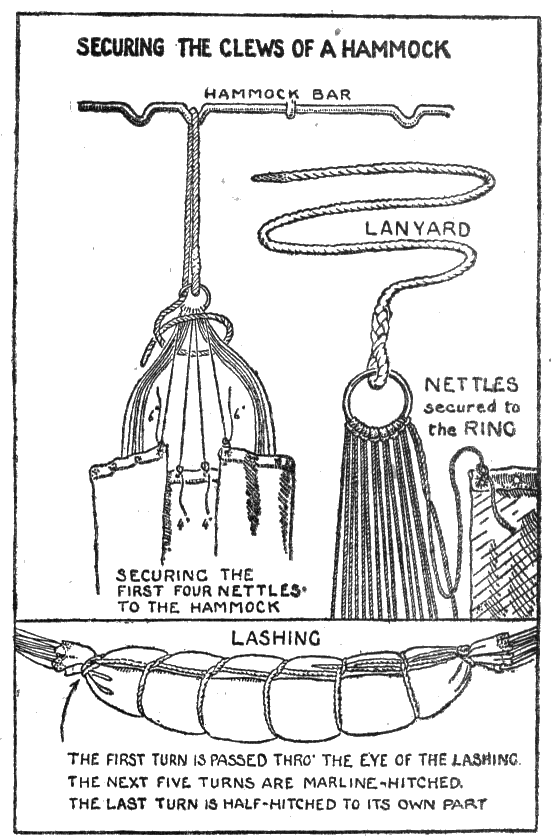Navy Life
Using a Hammock
The modern Navy uses "bunks" which the sailors commonly refer to as racks. But prior to the St. Laurent Class (built in the 50s-60s) it was common for a sailor to sleep in a hammock. The guidelines for the use of the hammock were actually fairly strict and steeped in tradition.
Parts of the Hammock
Hammock: The canvas part, having 16 holes in each end, usually fitted with eyelets.
Clews: 'A set of clews' consists of two lanyards, each spliced to its metal ring, each ring carrying eight nettles (six-foot lengths of 3-stranded white hemp 5/8 inch in circumference), for slinging the two ends of the hammock.
The nettles are first middled, with the eye so formed secured with a racking seizing; the eye is passed through the ring and secured by passing the two ends through the eye. As each nettle has two ends, sixteen ends are thus provided, one for each eyelet hole in the end of the hammock.
Lashing: A length of sisal long enough to allow the seven turns to be taken round the hammock and secured to its own part. The lashing has an eye-splice at one end and may be 'pointed' at the other.
How to Sling the Hammock
To sling the hammock secure one lanyard to the hammock bar overhead so that the ends of the nettles hang at the level of the chest. Pass the outer nettles through the outer corner eyelet holes at one end of the hammock and secure by a half-hitch, leaving about six inches of the ends hanging down. Then take the two nettles nearest the centre and secure them to their corresponding eyelet holes in the centre of the hammock-end, leaving about four inches hanging down. Then secure the remaining nettles in like manner from the centre outwards, leaving increasing lengths of end hanging.
Repeat with the other end of the hammock and the other clews. Plait the ends of the nettles up in threes, leaving them inside the hammock.
Sling the hammock between two hammock bars by passing the lanyard over the bar, back up through its own ring and form a sheet bend over the nettles. Then distribute the bedding evenly over the length of the hammock and tauten up the slack nettles if necessary.
Too keep the head of the hammock apart a stretcher can be used, but this is optional. It consists of a length of wood about two feet in length with a V cut out at both ends. These V's take over the top two nettles on each side.
How to Stow a Hammock
Distribute the bedding evenly over the length of the hammock leaving about six inches clear at each end to prevent bunches of bedding and blankets oozing out of the ends when it is lashed.
Lower the hammock until it is breast high, and stand on the left side facing the head. Pass the lashing over the hammock and reeve the end through the eye and draw taut; this is the first turn. There are to be a total of seven turns as shown in the diagram below. Traditionally, one turn for each of the seven seas.
Coil the lashing up and pass it up and over the hammock with the right hand and bring it under the hammock into the left hand, then over its own standing part and haul taut by swinging back on it. This hitch is called a marline hitch.
The final turn is taken around the neck of the hammock at the foot and is secured on its own part by a half-hitch. The end is then passed neatly along the hammock under each turn.
The clews are stowed by twisting the nettles round right-handed and tucking under the turns of lashing along the hammock.

